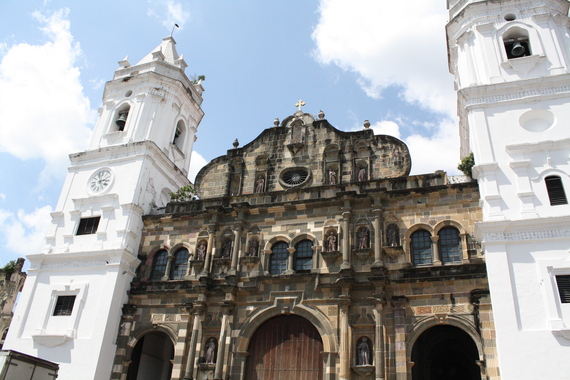Kathleen Peddicord at Live and Invest Overseas wrote a great article for Huffington Post. Here she explores one of my favorite place to visit in Panama City. It truly is a step back in time when you visit Casco
On one of my first visits to Panama, more than 15 years ago, a longtime friend who was living in Panama City at the time invited me to take a drive with him.
“I’m going to show you the best this city has to offer,” he promised.
We drove down Avenida Balboa, beyond the central zone of the modern city, turned left, and passed a brightly painted Chinese-style arch that seemed out of place in this Latino barrio.
But what lay beyond the Asian arch was perhaps more surprising: A treasure trove of historic structures left behind by the Spanish, the French, and the Americans, all of whom had hung their hats in this part of the world at different times over the preceding few centuries.
Like the arch, everything in this zone was crumbling, peeling, cracking, and fading. The gutters were thick with litter, and small barefooted children ran back and forth across the narrow brick-paved roadways in all directions.
From the open windows, Latin music blared. In the open doorways, women lounged and rocked, chatting and tending to their near-naked babies.
Some buildings couldn’t quite be described using that word. They were more piles of rubble than actual structures.
But if you looked beyond the litter and the rubber, beyond the crumbling plaster and the peeling paint, you saw something special, something that exists in only a limited number of places around the world: Block after block of classic colonial-style buildings with shuttered windows, balconies on every level overlooking the street, ornate iron work and turned wood, and facades of the kind you see more often in the pages of coffee-table books than in real life.
This was Casco Viejo that my friend introduced me to all those years ago. As soon as we’d turned the corner past the Chinese arch and into the barrio, I urged him to find a place to park so we could get out and have a closer look. I wandered up and down the streets that day with delight. I like old buildings the way some women like new shoes. For me, this was better than a shopping spree along Fifth Avenue.
The better I got to know Casco Viejo, or Casco, as locals refer to it, over the years, the more infatuated I became. This region of Panama City is quite separate from the rest of the capital, out on a small peninsula in the Bay of Panama. Almost any street in Casco eventually leads to the sea.
On its way to the water, each of these centuries-old roadways paved with brick takes you past those glorious colonial structures, and, as well, a well-laid-out series of plazas, each with its own church. Casco Viejo boasts eight historic churches in all, including Iglesia Felipe Neri, the oldest in the city, dating to 1688.
This is one part of Panama City built for walking, which is something else I appreciate about it. This ancient quarter is laid out like a classic European city, on a grid around those welcoming plazas with their shady trees.
Back then, on my first visit, it took considerable imagination to see the potential beneath the grime and the garbage. Most of the one-, two-, and three-hundred-year-old buildings were, at the time, crowded with a dozen or more inhabitants each, some legal, most not, some paying a pittance in rent thanks to a scheme something like rent control in central Manhattan. Many of Casco Viejo’s occupants at the time, though, were squatters, meaning that, before the buildings of this historic zone could be rejuvenated, its population had to be moved out.
Fast forward to today, more than a decade-and-a-half later, and the squatters are mostly gone, some moved to affordable housing provided by the Panama government. A good number of the old houses have been rehabbed, in most cases with tender loving care and attention to original detail, some converted to private homes, others to apartments, office buildings, art galleries and shops.
Today there are restaurants with sidewalk tables, open-air cafes on the corners, and trendy bars with live music. Today, the Casco is increasingly the place to go on a Friday or a Saturday night if you’re young and looking for fun.
That said, if you didn’t see Casco Viejo years ago, and you see it today for the first time, you might wonder what I’m waxing on about. Trendy? Romantic? Charming? “This place is little better than a ghetto!” you might exclaim…and you’d have a point.
The gutters are still strewn with litter (though nothing like a decade ago). Children still run barefooted in all directions. Women still lounge in the open doorways gossiping with their neighbors and nursing their newborns. The stray dogs are here and the blaring boom boxes, all the elements of a real barrio.
This is a neighborhood in transition, and many in Casco Viejo are keen not only to renovate the old colonial structures to their original glory, but to do so while preserving the cozy Panamanian community that has existed for decades among them.
Casco is, for me, both the most colorful, historic, and romantic section of Panama City and, as well, the most authentically Panamanian. When the sun is falling and the light fading, you can imagine Ernest Hemingway or Graham Greene coming around the next corner…
People typically love Casco Viejo or they hate it. You should come have a look and make up your own mind.


